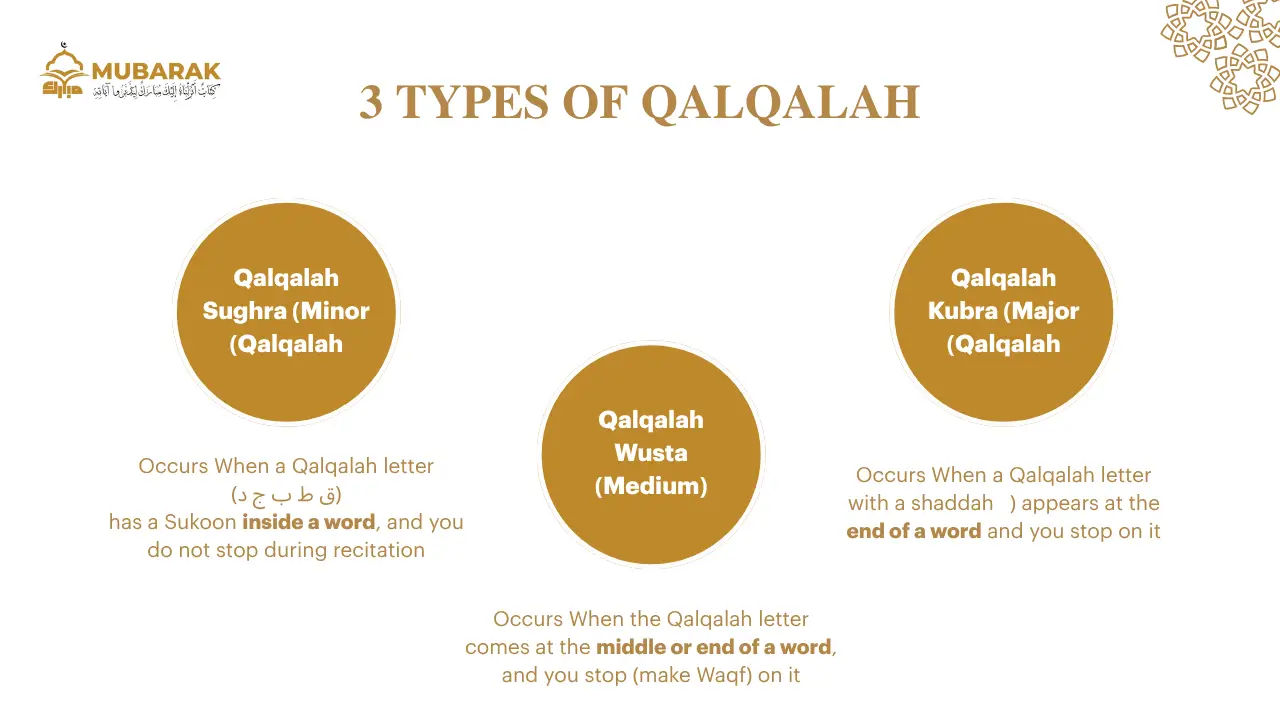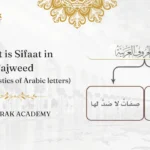The holy Quran contains many Tajweed rules that ensure your recitation is as prescribed. Qalqalah is the echo effect for certain letters, and it’s one of the most important rules of Tajweed, which helps you enhance your recitation and ensure you read correctly. Let’s learn more about this rule, identify the Qalqalah letters in Quran, and discover how to produce this sound through effective courses that will facilitate your learning journey.
What Is Qalqalah in Tajweed?
In Arabic, the word “قلقلة” (Qalqalah) means a kind of shaking or echoing, while in the recitation of the Qur’an, Qalqalah refers to the distinctive bounce or vibration you produce when certain letters are recited while carrying a sukūn (No vowel).
There are five Qalqalah letters in Quran (Called Hurūf-al-Qalqalah), which are: ق (Qaf), ط (Taa), ب (Baa), ج (Jeem), د (Dal). Whenever one of these letters appears with a sukūn (that small circle ْ above the letter or when you pause on it), you have to give a brief “bounce-back” or echo sound to ensure it doesn’t get swallowed or lost during recitation.
This echo isn’t just decorative; it helps in keeping the letter clear, sharp, and true to its correct pronunciation, enhancing both accuracy and beauty in your recitation.
5 Qalqalah Letters in Quran
It is necessary to know the letters of qalqalah in Arabic to be able to apply the rule. Qalqalah letters or Huruful Qalqalah are a group of five certain consonants, which are pronounced with a distinct echoing sound when they appear with a sukoon. They are:
| (Qaf) ق | (Taa) ط | (Baa) ب | (Jim) ج | (Dal) د |
|---|---|---|---|---|
| تُذكَّر بعبارة: قطب جد (Qutb Jad) |
||||
Once you find any of these Qalqalah letters in Quran, they should be pronounced with an echo-like vibration to beautify your recitation and commit to the Tajweed rules.
3 Types of Qalqalah
There are three main types of Qalqalah in Tajweed: Sughra (Minor), Wusta (Medium), and Kubra (Major):

1. Qalqalah Sughra (Minor Qalqalah):
- Occurs When a Qalqalah letter (ق ط ب ج د) has a Sukoon inside a word, and you do not stop during recitation.
- The echo or “bounce” is light because you continue reciting without a full stop.
- Example: In وَخَلَقْنَـٰكُمْ أَزْوَٰجًۭا (Surah An-Nabaʾ 78:8) the letter ق appears in the middle with a sukūn.
2. Qalqalah Wusta (Medium):
- Happens when a Qalqalah letter comes at the middle or end of a word, and you stop (make Waqf) on it (without a shaddah).
- The bounce is moderate: Stronger than Sughra but not as strong as Kubra.
- Example: (The letter ب at the end of the word) مَآ أَغْنَىٰ عَنْهُ مَالُهُۥ وَمَا كَسَبَ
3. Qalqalah Kubra (Major Qalqalah):
- Occurs when a Qalqalah letter appears at the end of a word or verse with a shaddah (or when stopping on it).
- The echo is strong and clear, marking the end of the word/verse distinctly.
- Example: In تَبَّتْ يَدَآ أَبِى لَهَبٍۢ وَتَبَّ (Surah Al-Masad 111:1) the letter ب in “تَبَّ” creates a strong Qalqalah when stopped on.
Summary Table
| Type | When It Happens | Bounce Strength |
|---|---|---|
| Qalqalah Sughra | Middle of word – no stop | Light |
| Qalqalah Wusta | End of word – without shaddah | Moderate |
| Qalqalah Kubra | End of word/verse – with shaddah or stopping | Strong |
By recognizing which type of Qalqalah applies (Sughra, Wusta, or Kubra), you’ll ensure your recitation remains accurate, clear, and melodious.
Qalqalah Letters Examples in Quran
We have 5 qalqalah letters that we mentioned above; now let’s take a look at the English and Arabic qalqalah letters in the Quranic text:
| The Letter | Example | Surah | Notes |
|---|---|---|---|
| ق – Qaaf | وَهُوَ الْحَقُّ مُصَدِّقًا لِمَا مَعَهُمْ قُلْ فَلِمَ تَقْتُلُونَ | Al-Baqarah (91) | The letter qaaf in “تَقْتُلُونَ” should be recited with Qalqalah. |
| ط – Taa | إِنَّ بَطْشَ رَبِّكَ لَشَدِيدٌ | Surah Al-Burooj (85:10) | The ط in “بَطْشَ” occurs with sukūn (if stopped) showing Qalqalah Sughra. |
| ب – Baa | تَبَّتْ يَدَا أَبِي لَهَبٍ وَتَبَّ | Surah Al-Masad (111:1) | The “ب” at the end of “تَبَّ” is a prime example of Qalqalah Kubra. |
| ج – Jeem | الْحَجُّ أَشْهُرٌ مَّعْلُومَاتٌ ۚ فَمَن فَرَضَ فِيهِنَّ الْحَجَّ.. | Surah Al-Baqarah (197) | The “جّ” shows the clear bounce effect when reciting. |
| د – Daal | وَلَمْ يَكُن لَّهُ كُفُوًا أَحَدٌ | Surah Al-Ikhlās (112:1–4) | When you stop at “أَحَدْ”, the “د” is echoed with Qalqalah. |
Other Qalqalah Examples from quran:
- بَلۡ كَذَّبُوا۟ بِٱلۡحَقِّ
- وَٱلنَّخۡلَ بَاسِقَـٰتࣲ لَّهَا طَلۡعࣱ نَّضِیدࣱ
- قَالَ ءَاتُونِیۤ أُفۡرِغۡ عَلَیۡهِ (قِطۡرࣰا
- وَإِن كُنتُمْ فِي رَيْبٍ مِّمَّا نَزَّلْنَا عَلَى (عَبْدِنَا
The Purpose and Beauty of Qalqalah
The text of the Quran is revealed in a certain way, with specific pronunciation, articulation, and rhythm. Applying Tajweed rules, of which the Qalqalah rules are an important part, helps us recite the holy Quran just as it arrived.
Allah (SWT) says in Surah Al-Muzzammil 73:4
“Read the Qur’an with measured recitation”
Just as our Prophet Muhammad (peace be upon him) recited it! That means we should be aware of each rule of Tajweed and recite the Quran carefully. Plus, producing the right sounds on Qalqalah letters in the Quran beautifies recitation and gives clarity and balance to your recitation, which makes it pleasant to the reciter and listeners as well.
Common Mistakes in Pronouncing Qalqalah
A good grasp of Qalqalah is a must for proper Quranic recitation; unfortunately, many reciters fall into common mistakes that can affect their recitation. These mistakes come from confusion about what Qalqalah letters in Quran need Qalqalah or how to apply it properly.
Here are the most frequent mistakes and how to avoid them:
- Bouncing back non-Qalqalah letters if you are not focused or not aware of Qalqalah letters in Quran. Therefore, it requires some practice in the beginning to ensure you can distinguish Qalqalah.
- Giving Qalqalah letters too weak an echo, especially at the end of a verse where a stronger resonance is required.
- Confusing or mixing the levels of Qalqalah (Sughra, Wusta, Kubra), for example using a strong echo inside a word or a light echo at the end of a verse.
Learn Qalqalah and Tajweed with Mubarak Academy
At Mubarak Academy, we are eager to teach you Tajweed with the most effective and engaging methods to enjoy the learning process. Therefore, we offer a Tajweed Quran Online course that facilitates the understanding of the basic rules in a fruitful Tajweed series with clear examples to deliver the meanings and practice while you learn.
If you need more explanation and practical aspects of the rule of Qalqalah and Qalqalah letters in Quran, you can join our course now!
With qualified teachers and tutors with a strong command of the Arabic language and the latest methods, you ensure great progress in a short time.
Recommended Courses:
- Quran Memorization Course
- Tajweed Quran Online Course
- Islamic Studies Course
- Arabic Language Course
- Quran Ijazah Course
Contact Us Now For More Details!
Conclusion
Qalqalah is an important rule that completes your recitation beauty. Your attempt to master it will be rewarded from Allah as long as you seek the proper recitation of the Holy Quran. Start today and learn this rule that adds beauty and clarification to your recitation.
Frequently Asked Questions
1. What are the main rules of Qalqalah in Tajweed?
Qalqalah applies only to five specific letters: ق (Qaf), ط (Taa), ب (Baa), ج (Jim), and د (Dal). The sound is produced when these letters carry a sukoon, meaning no vowel mark is present.
2. How can I practice Qalqalah?
Listen carefully to expert Qur’an reciters and mimic their pronunciation.
Recording yourself and comparing it to professional recitations helps refine your articulation and bounce.
3. How long does it take to learn Qalqalah?
Qalqalah is one of the easiest Tajweed rules to learn. With consistent listening, practice, and guidance, most learners can master it in a short time.




